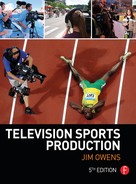Chapter 18
Milestones in Sports Broadcasting
July 12, 1928: Although some sources list tennis as being televised as the first sport on television, they were actually only images of a tennis player hitting a ball. It was not really a sports event.
February 17, 1931: The first closed-circuit telecast of a sporting event was a baseball game played by the Waseda University baseball club. The images were not seen by the public and were transmitted directly to the Electrical Laboratory at Waseda University in Tokyo (see Figure 18.2).
Television, What’s in a Name?
In the early 1920s, it was called visual listening, audiovision, telectroscopy, telephonoscope, raduo, electric vision, and radiovision. Finally, television seemed to be the name everyone accepted. The name television comes from “tele” (far off) and “vision” (to see).
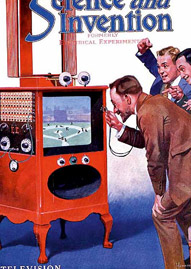
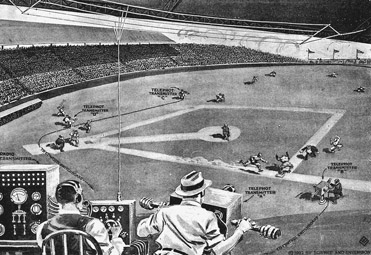
Figure 18.1
July 1922: H. Gernsback published, in Science and Invention magazine, detailed drawings of how sports will be covered in the future. While numerous experiments had been completed up to this point, television is not really considered invented until 1926.
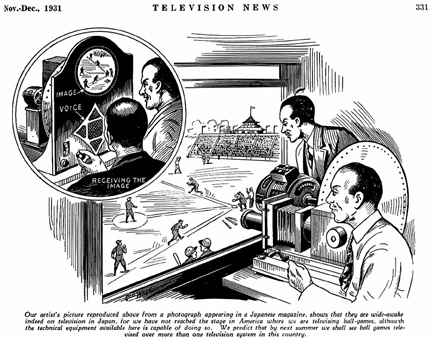
Figure 18.2
Photo etching of the first closed-circuit telecast of a sporting event.
Source: Courtesy of Television News, November–December 1931.
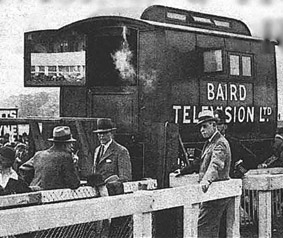
Figure 18.3
The entire vehicle shown above was the camera used to cover the first broadcast sports event.
Source: Courtesy of Radio News, March 1932 and Tom Genova.
June 2, 1931: The earliest true broadcast (available to the public) of an outdoor sporting event was the BBC’s coverage of The Derby (horse race) at Epsom in Great Britain. The production’s mechanical television equipment utilized one camera. A movable mirror was used to focus the images of the horses into a large wagon, which contained the camera apparatus. Thus, spectators were able to view the entire race from start to finish. The audio and video images were transmitted separately to the home viewer (see Figures 18.3, 18.4, and 18.5).
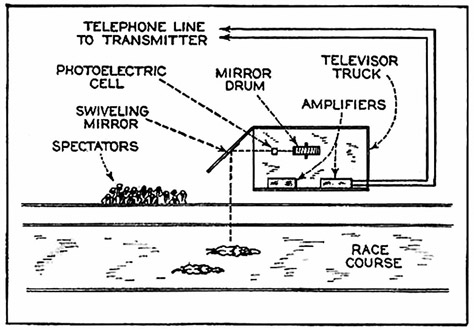
Figure 18.4
The “swiveling mirror” is illustrated in the above drawing. It utilized a moving mirror in order to follow the running horses.
Source: Courtesy of Radio News, March 1932 and Tom Genova.
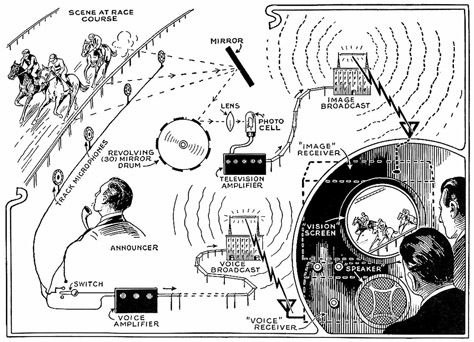
Figure 18.5
The first sports broadcast transmitted its video over one channel and its audio over a radio station.
Source: Courtesy of Television News, September–October 1931 and Tom Genova.
1936: The first live television coverage of a sports event, utilizing electronic equipment, was the 1936 Berlin Olympics. RCA and Farnsworth cameras were used for the coverage. One of the three cameras was capable of live coverage, but only when the sun was shining.
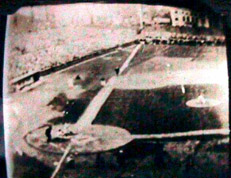
Figure 18.6
Taken in 1933, this is the earliest known image from a television sports event. The photo was from the private collection of inventor Vladimir Zworykin and was a time exposure of the image on a kinescope. This baseball game took place at the Boston Braves Field and was probably shot with a camera that had 240 lines.
Source: Photo courtesy of Steve Restelli.
1936: Leni Riefenstahl filmed the 1936 Olympics for the documentary Olympia. Her innovative use of dramatic film techniques on a sports event changed the world of film and television sports. The use of tracking dollys, underwater cameras, cameras on hot-air balloons, dive cameras, and low/high angles had never been attempted before on sports coverage. Broadcasting the Olympics, an International Olympic Committee publication, states that “the shooting techniques used by Leni Riefenstahl have become the standards for Olympic filmmaking and television coverage ever since.”
1937: First tennis tournament on television: Wimbledon.
February 4, 1937: The first time that sports commentary was heard on television. The BBC hired Herry Mallin to comment on an England versus Ireland amateur boxing contest from the Alexandra Palace.
September 16, 1937: The first football (soccer) match to be filmed live on television was between Arsenal and the Arsenal Reserves in Highbury, England.
May 15–21, 1939: The first telecast of a bicycle race was broadcast by the National Broadcasting Company. The six-day race featured 12 teams, eight of which finished the 2,388-mile event. Yankee baseball player Joe DiMaggio fired the starting gun.
June 1, 1939: First heavyweight boxing match televised, Max Baer versus Lou Nova, from Yankee Stadium.

Figure 18.7
An early remote television mobile unit from RCA from 1939–1940.
Source: Courtesy of Bill Molzon and Steve McVoy.
August 26, 1939: First Major League Baseball game telecast, a double-header between the Cincinnati Reds and the Brooklyn Dodgers at Ebbets Field, Brooklyn, announcer Walter L. “Red” Barber or Bill Stern (sources differ), on W2XBS.
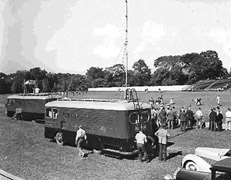
Figure 18.8
First televised college American football game on September 30, 1939.
Source: Courtesy of David Sarnoff Library.
September 30, 1939: First televised college football (American style) game, Fordham versus Waynesburg, at Randall’s Island, New York, on W2XBS (see Figure 18.8).
October 22, 1939: First NFL game is televised by W2XBS: Brooklyn Dodgers versus Philadelphia Eagles at Ebbetts Field in Brooklyn. Play-by-play announcer was Allen “Skip” Walz.
February 25, 1940: First hockey game televised, Rangers versus Canadians, on W2XBS, from Madison Square Garden.
March 2, 1940: First televised track event, from Madison Square Garden.
October 5, 1940: WPTZ-TV was the first in the country to carry a complete football (American style) schedule—all home games. With only 700 television sets scattered throughout the Philadelphia area, Philco broadcast the University of Pennsylvania’s Quakers 51–0 victory over the University of Maryland at Franklin Field.
June 19, 1946: First televised heavyweight title fight (Joe Louis versus Billy Conn), broadcast from Yankee Stadium, was seen by the largest television audience to see a fight (141,000).
September 30, 1947: The first World Series game to be telecast was between the New York Yankees and the Brooklyn Dodgers at Yankee Stadium. The game was carried by WABD, WCBS-TV, and WNBT in New York, and was also telecast in Philadelphia, Schenec tady, and Washington. The 1947 World Series brought in television’s first mass audience, and was seen by an estimated 3.9 million people, mostly in bars (Tim Brooks).
July 14, 1951: The first “color” sports event was the $15,000 Molly Pitcher Handicap held at the Monmouth Park Jockey Club in Oceanport, New Jersey. This event was broadcast using the CBS Color Television System, which was pre-NTSC.
September 22, 1951: First live sporting event seen coast-to-coast in the United States: a college football game between Duke and the University of Pittsburgh, at Pittsburgh (NBC-TV).
1955: The Helivision anti-vibration helicopter camera mount was invented by French director/cinematographer Albert Lamorisse.
November 1, 1959: WLWT-TV televised the first indoor sports event in television history in color, the Cincinnati Royals pro basketball game from the Cincinnati Gardens. It was fed to NBC.
April 1960: Ampex introduced the Intersync accessory, which made it possible to cut to or from videotape without rolls or discontinuity and to do dissolves and some special effects.
May 16, 1960: WLWT-TV (USA) televised the first night Major League Baseball game in television history in color from Crosley Field. Three RCA TK-41 color cameras equipped with low light tubes were used.
August 25, 1960: The opening of the 17th Olympic Games in Rome is transmitted live via the Eurovision link. Videotape was used by broadcasters for the first time at an Olympics.
March 17, 1962: ABC Sports (USA) used special rerun equipment to replay portions of a boxing match.
December 7, 1963: CBS aired the first instant replay during a football game in Philadelphia.
October 10, 1964: First live color satellite broadcast in history was the opening ceremonies of the 1964 Summer Olympics in Tokyo.
August 1965: MVR video disc machine was built to CBS specifications and was used for instant replays of football games.
April 1967: Ampex introduced the first batterypowered portable high-band color tape recorder. Weighing 35 pounds, it could record for 20 minutes. The accompanying camera weighed 13 pounds.
April 1967: Ampex announced high-band color video disc machine HS-100 for instant replays. ABC used it for slow-motion playback of downhill skiing at the World Series of Skiing—an early, if not first, use of slow-motion instant replay in sporting events (see Figure 18.10).
1968: NHK in Japan began work on high definition television (HDTV).
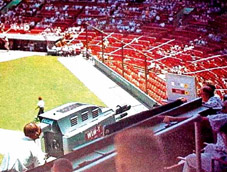
Figure 18.9
In the 1960s, this camera was responsible for the infield, outfield, and graphics.
Source: Courtesy of Lytle Hoover.
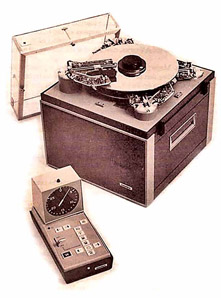
Figure 18.10
In 1967, Ampex introduced a color video disc machine that could be used for instant replays.
1968: Ampex HS-100 video disc recorder with slow-motion and stop-action facilities was used for first time by ABC during Olympic Games.
1969: Development of first handheld video camera.
1969: First exhibition of HDTV at STRL open house (Japan).
1976: Steadicam camera mount, devised by Garrett Brown, was introduced.
1984: Olympic Games were broadcast in stereo. NHK shot some of the Olympic sports in HDTV.
June 3, 1989: Japan began regular high definition television transmissions by satellite.
1998: Nagano Olympics included the first video-on-demand coverage and filmed some sporting events in 3D high definition.
October 1, 1998: Major League Baseball began streaming video on the Internet of post-game conferences, playoff game highlights shortly after each game, and the greatest moments in baseball.
December 1, 2000: Digital satellite broadcasting began in Japan.
2001: Major League Baseball streamed realtime video of games over the Internet.
May 31, 2003: The Women’s National Basketball Association (WNBA) featured the first ever live video webcast of a game in women’s professional sports history (see Figure 18.11).
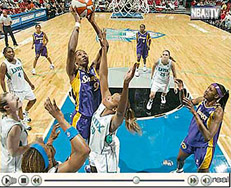
Figure 18.11
In May 2003, the WNBA featured the first ever live video webcast of a game in women’s professional sports history.
November 2003: MobiTV became the first streaming television content service that delivered live television programming to mobile phones.
August 2004: Broadcasters at the Athens Olympics streamed video and highlight clips of the Olympic Games through mobile phone handsets and via the Internet. The BBC called the Athens Olympics the “Interactive Olympics.”
February 2006: Torino Olympics was the first all-HD Olympics by NBC and the first time Olympic coverage was available on a mobile phone.
December 4, 2008: The first live 3D broadcast featured the National Football League’s Oakland Raiders and the San Diego Chargers.
June 20, 2009: Major League Baseball streamed its first live baseball game—the Cubs versus the White Sox—to iPhones equipped with MLB’s “At Bat” app. This was the first time a major sports content provider bypassed the television broadcast infrastructure to bring programming directly to the end users.
January 1, 2010: Sky launched the world’s first all-3D channel, Sky 3D.
January 2010: BSkyB became the first broad-caster in the world to show a live sports event in 3D when Sky Sports screened a football match between Manchester United and Arsenal to a public audience in several selected pubs.
2010: NHK shot the Tokyo Marathon in Ultra-High Definition (UHDTV), previously called Super Hi-Vision, which included 22.2 multichannel sound.
February 2012: First Super Bowl streamed, becoming the largest social media event for TV in history. There were over 2 million unique users with 4.5 million live streams online, a milestone for Internet live distribution of video. Over 5.4 million people posted 12.2 million comments during the game.

Figure 18.12
NHK and the BBC produced and distributed some Olympic events in Ultra-High Definition (8K). This older HD truck was retrofitted into the only 8K production van in the world in 2012.

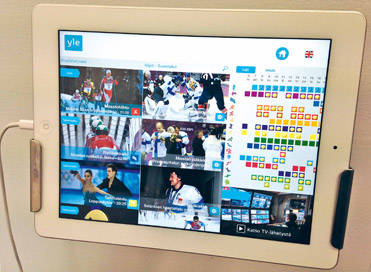
Figure 18.13
Olympic Broadcasting Services provided their Olympic Video Player to broadcasters at the Sochi Olympics. Viewers could watch it on tablets and smartphones.
July 2012: First Olympics (London) broadcast live in 3D and the first time a live event was produced and distributed around the world in Ultra-High Definition. The 8K production was produced as an experiment by the BBC, NHK, and Olympic Broadcasting Services (see Figure 18.12).
June 2013: The world’s first 4K OB vehicle, Telegenic’s T25 truck, used seven 4K cameras to produce the Confederations Cup in Brazil.
August 2013: BSkyB transmited the first 4K television satellite broadcast. The program was a soccer game between two British teams, Stoke City and West Ham.
February 2014: For the first time in Olympic broadcast history, more hours were broadcast on digital platforms than television/ linear platforms, enabling Olympic fans around the world to follow the action wherever and however they liked, with live and on-demand Internet and mobile coverage provided by Rights Holding Broadcasters within their respective territories (see Figure 18.13).
May 2014: First 4K Ultra HD live streaming event was produced by French broadcaster TDF of the French Open 2014 tennis championship.
(Compiled with input from Iain Baird, earlytelevision.org, Ed Reitan’s Color Television History, Philo T. Farnsworth Archives, Lytle Hoover, terramedia.co.uk, Alexander B. Magoun, David Sarnoff Library, sportandtechology.com, WLWT, Temple University Urban Archives, TV Acres, tvhistory.tv, oldradio.com, and Tom Genova)
It is very difficult to say exactly who really “invented” television; so many individuals were working around the world on the project. The “inventor” title is based on how you define television. However, there are two individuals who seem to have had the most impact at the beginning of television.
John Logie Baird, of Scotland and later England, was the inventor of mechanical television in 1926. He was the first person who was able to create a visual transmission of a television image. While his mechanical system was defunct in a few years, he continued to experiment and was the first person to ever televise a sports event (see the description of the first sports broadcast from the Derby). His later work included color television, high definition television, and some of the foundation for television as it is today.
Philo T. Farnsworth is credited as being the inventor of electronic television in 1927. While his methodology was significantly different from Baird’s, his early television tube was the foundation for electronic television. Farnsworth also created the first television camera and was able to sell his technology to organizations all over the world. In fact, Fernseh, the television production company who televised the Olympics in 1936, used some of Farnsworth’s cameras in their coverage.
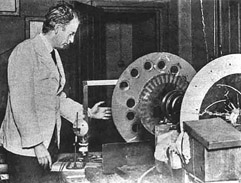
John Logie Baird (Courtesy of tvhistory.tv)
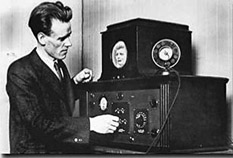
Philo T. Farnsworth (Courtesy of the Philo T. Farnsworth Archives)
